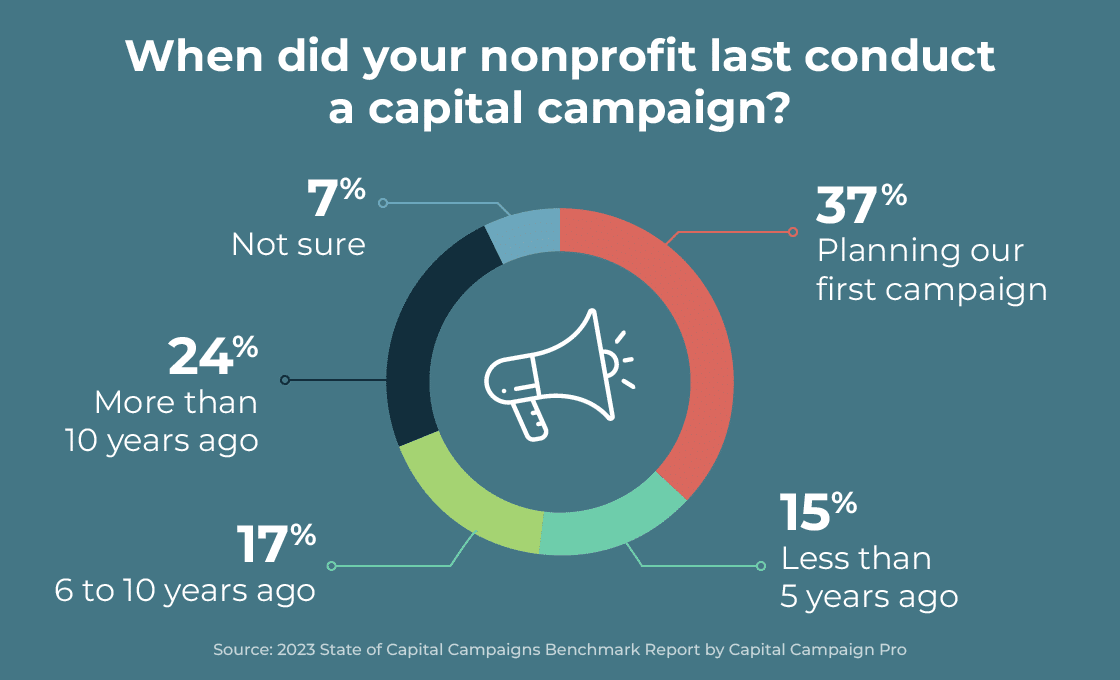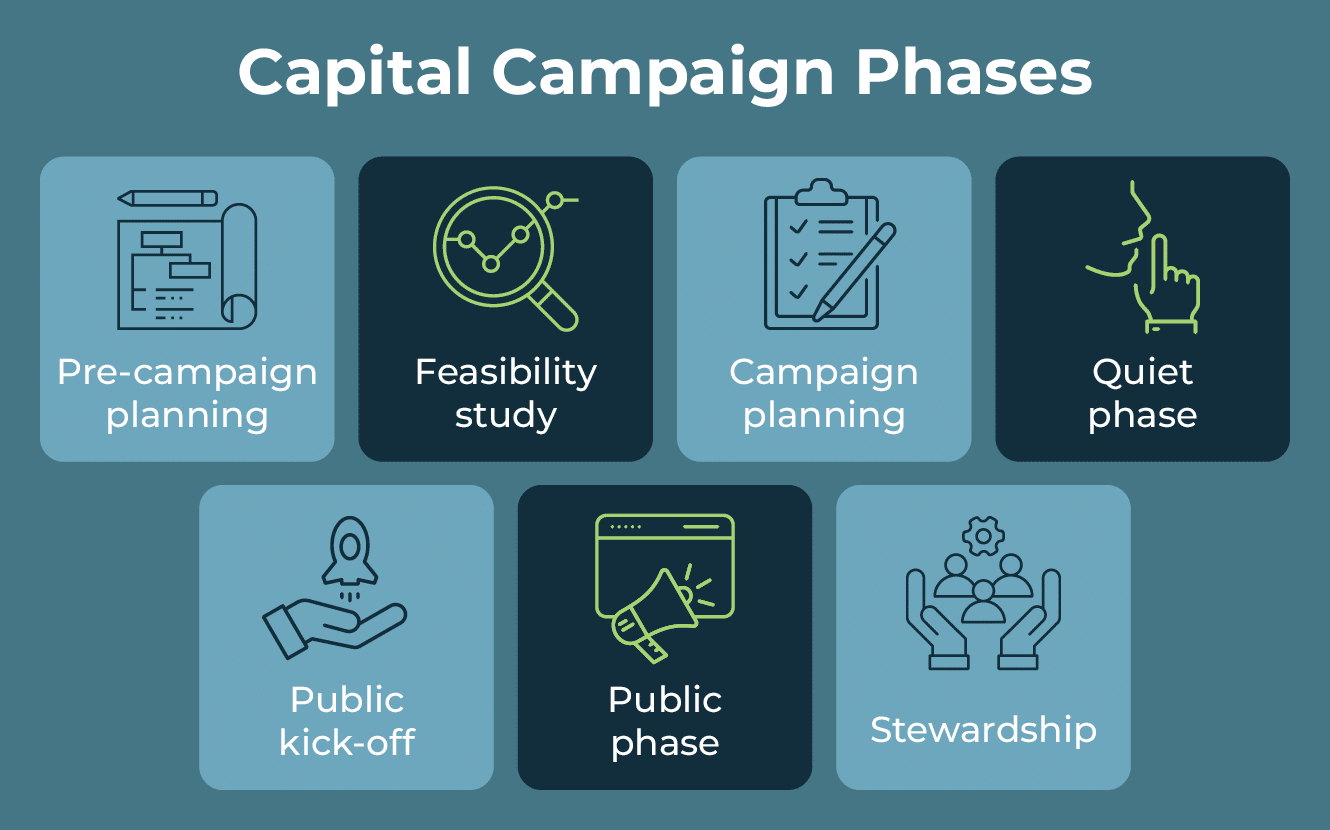Capital Campaign

A capital campaign is a large-scale fundraising effort conducted by a nonprofit organization in order to bring in a large injection of capital investment.
These campaigns are quite large and ambitious (raising much more than an organization ever has in the past), so they must be approached strategically to succeed. Adapt your plans and goals so you can follow best practices for a successful campaign.
What is a capital campaign?
A capital campaign is a multi-faceted effort to reach a significant fundraising goal. The funds raised will pay for important capacity investments that enable organizations to continue growing sustainably. For example, a nonprofit might undertake a capital campaign when looking for funding for a new office building, a major piece of equipment, or a relocation fund.
Capital campaigns usually have a single large objective or a bundle of smaller objectives and a specific timeframe to reach the financial goal; the campaign is conducted outside the regular programs and annual funding efforts for a given year.
Capital campaigns differ from standard fundraising campaigns in a number of ways. First, they raise funds to actively build the organization’s capacity, not necessarily to fund ongoing programs or operations. They also last much longer and raise significantly larger sums than normal annual campaigns. Capital campaigns rely heavily on major gifts and, as a result, must follow strategic solicitation strategies.
How long do capital campaigns last?
Although the timeline varies given the scope of the project, capital campaigns usually run for three years or more. The 2023 Capital Campaign Benchmark Report found that campaigns conducted by surveyed organizations lasted 3.2 years on average.
It’s important to note that capital campaigns occur infrequently since they’re intended to be special projects that ratchet an organization up to its next level of growth.

The study cited above found that among surveyed nonprofits, 37% were conducting their very first campaign, 15% had conducted a campaign within the last five years, 17% between 6 to 10 years ago, and 24% more than 10 years ago.
What are a capital campaign’s objectives?
A campaign’s objectives are the specific projects that the money raised will fund. The most successful capital campaigns define their objectives that lead to highly compelling cases for support for their donors.
Common capital campaign objectives include:
- Building and renovation projects
- Relocation or building purchase funds
- Startup funding for new programs and services
- Increased staff, equipment, and training
- Grant, scholarship, and endowment funding
The campaign will focus on just one of these major goals to direct more attention toward the nonprofit’s greatest needs.
What does your nonprofit need to know before undertaking a capital campaign?
Before diving into a major campaign, nonprofits should understand a few common practices and misconceptions, especially if they’re planning their very first capital campaign.
- Capital campaigns tend to be time-consuming and will most likely be the focus of any nonprofit’s fundraising activities for a considerable period of time. Many nonprofits hire consultants who work solely on capital campaigns to support your team and stretch your bandwidth.
- It costs money to conduct an effective capital campaign, usually around 10% of its total fundraising goal, for things like consulting, increased fundraising staff, technology, and events. Campaign leaders and board members need to be on the same page about budgeting early in the process. Costs are commonly folded into the overall fundraising goal so that the campaign can ultimately pay for itself.
- Capital campaigns are not intended to raise unrestricted funds for general operating costs. They should be treated as special occasions, with solicitations focused on very specific objectives that will concretely grow your organization’s ability to drive impact.
- Nonprofits of all sizes can conduct successful capital campaigns. Although they may have smaller goals than major organizations, small nonprofits often reach and exceed their goals, especially when they put extra emphasis on building donor relationships and engaging board members.
What are the benefits of a capital campaign?
Aside from funding your objectives and growing your nonprofit impact with new projects, capital campaigns bring additional benefits like:
- Rallying an energized supporter base to support your mission
- Increasing the likelihood of attracting new major donors
- Motivating established donors to give again
- Engaging the local press and increasing your nonprofit’s public profile
Successful capital campaigns also bring many positive internal changes, as nonprofit teams learn and retain valuable lessons along the way. Respondents in the 2023 Capital Campaign Benchmark Report cited these are the top post-campaign benefits they’ve enjoyed:
- Strengthened major donor relationships
- Increased effectiveness at soliciting large gifts
- Increased overall effectiveness of development staff
- The development of better internal fundraising systems
- Increased board engagement with fundraising
How do you plan a capital campaign?
Capital campaigns traditionally follow a phase structure:

- Pre-campaign planning
- Feasibility study
- Campaign planning
- The quiet phase
- Public kick-off
- The public phase
- Wrap-up and stewardship
This structure gives you plenty of time and flexibility to lay out an effective plan and then strategically solicit donations, starting with your major donors.
Pre-planning your campaign
Start by outlining the main framework for your campaign. To reach a working goal, determine your objectives and tally up their costs. Lay out a rough plan for how you’ll see your goal through by developing a gift range chart, also called a donor pyramid. This resource details the number of gifts of different sizes that will add up to your total goal, starting with a small number of very large donations and working down to larger numbers of smaller gifts.
This is also when you should develop your campaign’s initial case for support. This guiding set of messages and arguments will be used to explain the campaign and ask for gifts.
The feasibility study
This important early step tests your plans to identify any changes you should make to ensure success. A feasibility study gathers the thoughts and feedback of your campaign’s key stakeholders, including donors, organizational leaders, and community partners.
The findings will help you finalize your working goal and lay out a more robust plan for the campaign.
Campaign planning
With the results of the feasibility study, you can adjust your goal up or down, develop a finalized campaign plan and timeline, and refine your case for support.
You’ll also need to conduct all the necessary prep work and gather resources for your campaign before fundraising can begin in earnest:
- Bring the people who will work on the campaign together, give them concrete deliverables, and set deadlines for each task.
- Create the budget and assign respective resources to the campaign leaders.
- Ensure your nonprofit CRM and supporter database are clean and organized.
- Hold regular update meetings and make adjustments to your strategy and tactics as necessary.
- Reach out to key stakeholders, supporters, and donors who will participate in your campaign roll-out.
- Polish your donation channels, such as your online giving page, and begin preparing the resources and documents you’ll use during donor conversations.
The quiet phase of fundraising
The quiet phase is when you secure the majority of your fundraising goal from major donors, starting with the small number of top donors identified in your gift range chart.
Industry experts suggest that 75% of your ultimate goal should be reached in this initial period. Waiting to publicly broadcast your campaign after this period allows you to focus exclusively on your most important and impactful gifts. A successful, quiet phase will drive significant campaign progress and deepen your relationships with major donors as they get excited about your nonprofit’s future growth.
Publicly kicking off your campaign
Once you’ve reached 75% or more of your campaign goal and a successful conclusion is in sight, you’re ready to publicly kick-off your campaign. Many nonprofits start this phase with groundbreaking ceremonies for their construction projects or other exciting announcement events.
The public phase of fundraising
At this point, the end of your campaign should be within grasp. Reach out to the press, email your supporter base, post on social media, and send your direct mail appeals. Host events and gin up excitement and enthusiasm among your community as you solicit smaller donations from large audiences.
Wrapping up and evaluating your campaign
Once your campaign concludes, celebrate the results, thank your donors, and highlight the impact that their gifts will enable. Pay extra attention to your major donors and take steps to keep them engaged with the funded projects over time.
This is also when you should gather as much information as you can about the campaign and how your efforts unfolded. Use your fundraising software to determine your successes and areas for improvement. What will this money mean for your organization? What can you do in the future to ensure future fundraising efforts are successful? What would you do differently next time around?
As you begin using the campaign’s funds to fuel action, be prepared to continue reporting on your progress and engaging donors. Your donors were integral to your success, so keeping them in the loop on your organization’s growing capacity will help build stronger relationships.